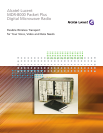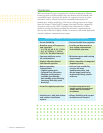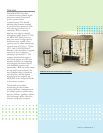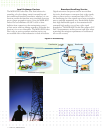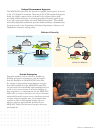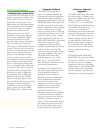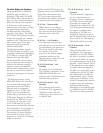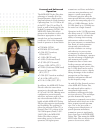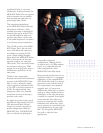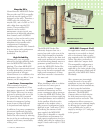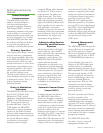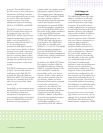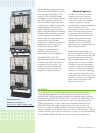
14 Alcatel-Lucent | MDR-8000 Packet Plus
p
rotocols. The parallel interface
provides access to radio and station
information, including both radio
and station alarms and status, as well
as controls. The serial interface
supports a variety of network
management protocols including
MCS-11, E2A/TBOS, and SNMP.
The MCS-11 protocol consists of
RS-422 formatted data which can
be transported over one of the
MDR-8000’s 64 kb/s digital service
channels, independent of the radio
traffic, to an external MCS-11
Monitor Control System. MCS-11
is a 4-wire, poll/response,
synchronous, half-duplex monitor
and control system whereby a master
(primary) station polls one remote
(secondary) station at a time and
waits for a response before polling
the next station. Poll and response
messages are carried in the service
channel transparent overhead bit
streams.
E2A/TBOS (telemetry byte-oriented
serial) is a 4-wire serial interface
conforming to the EIA RS-422
standard per Telcordia (Bellcore)
Publication 49001. Poll and response
messages are communicated to the
radio via an external fault alarm
remote or PC.
Increasingly, as telecommunications
networks evolve, network operators
are scrambling to harmonize
management of equipment that
spans multiple vendors and multiple
protocols. SNMP allows network
operators to bring equipment
t
ogether under one common network
management umbrella. Based on
Telecommunications Management
Network (TMN) standards, SNMP
provides a vehicle to improve
interoperability between equipment
vendors and simplify network
management for operators. SNMP
network management is enabled in
new or existing MDR-8000 Packet
Plus radios by the simple installation
of the optional TMN interface
module. The TMN interface module
supports SNMP transport over
TCP/IP LAN and serial point-to-
point facilities. The MDR-8000
Packet Plus is compatible with
SNMP V1, V2, and V3. The SNMP
MIB (management information
base) for the MDR-8000 Packet
Plus supports complete management
(alarms, status, controls, performance,
and provisioning) of the radio.
In addition, the MDR-8000 Packet
Plus supports a feature called the
Extended Link Monitor Channel
(ELMC). A standard feature of the
radio, the ELMC extends the
functionality of the User System
Interface (USI) to allow the local
craft person to remotely view the
provisioning, alarms, and status
information and control commands
for any radio, contiguously
connected to the network. The
performance monitoring, alarm
and status information, and remote
controls are accessible through
the ELMC channel, independent
of network management interfaces.
Remote provisioning and
downloading capability is also
supported by the ELMC channel.
Full Range of
Configurations
The MDR-8000 Packet Plus radio
family is available in a full range
of configurations, to meet every
network requirement and budget
constraint. Nonstandby and hot-
standby configurations are supported
in both linear and ring modes, while
frequency diversity and collapsed
rings are also available. In addition
to equipment protection, space
diversity receivers can be combined
with any of these configurations to
overcome path propagation
problems. With a dual receiver
module available, space diversity
can be easily added to nonstandby
radios at minimal cost. The dual
receiver module supports space
diversity operation, economically
and efficiently, in the same profile
as a traditional single receiver
subsystem. For ultimate path
protection, both space and frequency
diversity can be combined in a
quad-diversity configuration. When
using the dual receiver module in
quad diversity configurations, all
four receivers can be populated in a
single shelf, minimizing the size of
the deployed system. Quad diversity
is extremely useful for overcoming
the challenges of troublesome paths,
such as those covering very long
distances or transmitting over water.
For microwave routes that require
high-density cross sections, such as
multiple OC-3 channels, the MDR-
8000 Packet Plus also provides a
MultiChannel configuration. While



